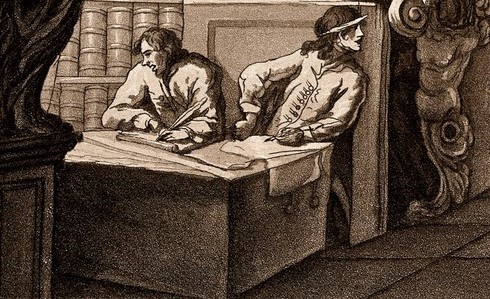The project’s research into salaried overseers, called assistant or perpetual overseers in the contemporary terminology, took us to the Durham County Record Office. The chapelry of Lamesley in County Durham holds a very unusual collection of sixty five letters, all written in May or June 1831, in relation to the same post for this sort of job. Thirty one men wrote on their own behalf, while others wrote references or testimonials in support of their application.
This flurry of administrative activity was sparked by an advertisement, placed in newspapers for Durham and Newcastle on Tyne, for an assistant overseer. The terms of employment were stringent: in exchange for £60 per year, the appointee was asked to live in the chapelry, have no other occupation, and to offer securities of £200 against the risk of malpractice in office. The candidates would undergo ‘election’ on Friday 10 June at 3pm.
What does this have to do with the project’s focus on Cumbria (including selected parishes in former Westmorland)? The appeal of this post was felt far and wide, attracting applications from Liverpool and other places some distance west and south of Lamesley. An application from Brough in Westmorland came from one George Pearson, who in comparison to some of the applicants wrote rather a good letter in terms of both handwriting and details of his occupational background.
Pearson described himself as a married man of 34 years old. He had been a clerk to Mr Blackett at his colliery works, left Mr Blackett in 1819 to be clerk to the London Lead Company, and remained there for eleven years. He gave up that employment owing to ill-health, and on recovering began teaching in a school at Brough ‘as an occupation rather than to make a living by it, there being over many schools in Brough before I began’. He claimed to be well-versed in accounts, to have property exceeding the requisite security bond, and to command references for his religious and moral character. He named referees including a banker, a reverend, and four others including Mr Blackett.

Pearson’s letter went on to ask about the duties required of the post-holder, and his chances of success. He gave an unusual account of his faith, in that he was a member of the Methodist Society but an attender at Church, to the extent of being a churchwarden at Longmarton and establishing a large Sunday School there (where the teachers were nearly all Methodists, apparently).
His application looked quite professional, but struck a plaintive note: the salary on offer at Lamesley was less than half of the total he had commanded at the London Lead Company, ‘but such is the competition for situations and so numerous are applicants’ that during the previous year he had visited Liverpool, Newcastle and other places with ‘the best’ recommendations but without success.
But Pearson’s story doesn’t end there, because he spent some time considering his position and eventually withdrew from the appointing process at Lamesley. He explained his reasons in a letter, and in doing so gives us extra insight into the recruitment of assistant overseers. He wrote on 7 June ‘as all the ratepayers have a vote in the election and have been canvassed by different parties, several of whom may be every way eligible, the choice will probably fall on one who belongs to the neighbourhood and is connected by friends with the parish: the chances of success for a stranger would in consequence, I fear, be so slight as not to warrant the expense I should incur in coming over’. Who knew that you had to ‘canvas’ for ratepayers’ votes to secure a post as assistant overseer this early in the nineteenth century? There was a contested election for the assistant overseer of St Chad’s in Lichfield in 1843, where it is evident that canvassing had taken place, but this was under the ‘New’ poor law of 1834 (where the Guardians of each Union had to be elected, so a culture of electioneering for poor-law offices was more pervasive). And Pearson was not simply making a false assumption because at least three other applicants either refer to their own ‘canvas’ or that of other candidates.
The letters in the Durham archives provide a fascinating insight into the evolution of the job application as a genre of writing, but they also offer us detailed guidance on the tensions and opportunities for aspiring assistant overseers. A single post could be hotly contested, drawing interest from beyond county boundaries. Lamesley is plainly not in the modern county of Cumbria, but its evidence in this respect will form a key component in our writing about the holders of assistant overseer posts.
Oh, and the job? It went to a Mr William Wren, who lived in Lamesley and had already been an assistant overseer in a different location during ‘a most arduous and difficult period’. But that is another story.
Sources: Newcastle Courant, 21 May 1831; DCRO EP/LAM 7/174-240.